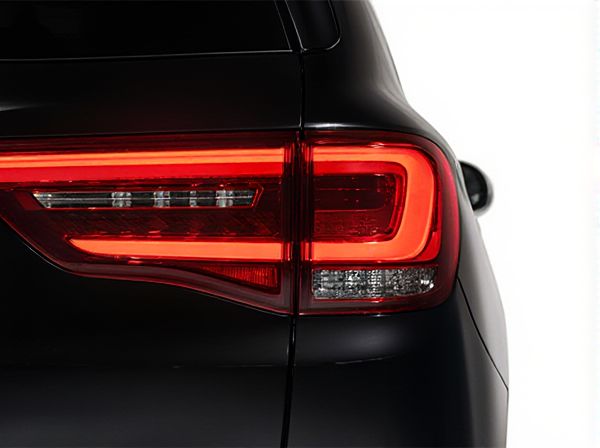
Photo illustration: Full-LED Taillight vs Hybrid Taillight
Full-LED taillights offer superior brightness, energy efficiency, and faster response times compared to hybrid taillights, enhancing both safety and aesthetics. Hybrid taillights combine LED and traditional bulb technology, providing cost-effective lighting but with less uniform illumination and slower activation. Choosing Full-LED taillights ensures your vehicle benefits from modern, long-lasting performance and a sleek, consistent glow.
Table of Comparison
| Feature | Full-LED Taillight | Hybrid Taillight |
|---|---|---|
| Lighting Technology | 100% LED bulbs | Combination of LED and traditional bulbs |
| Brightness | High intensity, uniform light | Moderate brightness |
| Energy Efficiency | Low power consumption | Higher power usage due to mixed bulbs |
| Durability | Long lifespan, resistant to damage | Shorter lifespan due to conventional components |
| Response Time | Instant illumination | Slower response than full LED |
| Cost | Higher initial cost | More affordable upfront |
| Maintenance | Minimal maintenance required | Requires periodic replacement of bulbs |
| Aesthetic Appeal | Modern, sleek design | Traditional appearance |
Introduction to Taillight Technologies
Full-LED taillights utilize light-emitting diodes to provide sharper illumination, faster response times, and greater energy efficiency compared to traditional lighting technologies. Hybrid taillights combine LED elements with conventional incandescent bulbs, aiming to balance cost-effectiveness and improved visibility. Advances in taillight technologies enhance vehicle safety by optimizing brightness, longevity, and design flexibility.
What is a Full-LED Taillight?
A Full-LED taillight utilizes light-emitting diodes for all rear lighting functions, including brake lights, turn signals, and reverse lights, offering enhanced brightness and faster response times compared to traditional bulbs. This technology improves energy efficiency and durability while delivering sharper visibility and design flexibility for automotive manufacturers. Full-LED taillights contribute to improved road safety by providing clearer signals to other drivers in various lighting conditions.
Understanding Hybrid Taillight Systems
Hybrid taillight systems combine Full-LED technology with traditional lighting elements to balance brightness, energy efficiency, and cost-effectiveness. These systems leverage LEDs for brake lights and signals while retaining conventional bulbs for other functions, optimizing overall performance. Understanding hybrid taillights involves recognizing their role in enhancing visibility and longevity without the full expense of all-LED setups.
Design and Aesthetic Differences
Full-LED taillights offer a sleek, uniform glow with precise light distribution, enhancing modern vehicle aesthetics through seamless, crisp lighting patterns. Hybrid taillights combine LED technology with traditional incandescent bulbs, creating a layered lighting effect that provides a mix of brightness and warmth but may lack the minimalist elegance of all-LED designs. Design-wise, Full-LED taillights enable more intricate shapes and animations, boosting visual appeal and brand identity, whereas Hybrid taillights often maintain conventional silhouettes with subtle contemporary touches.
Energy Efficiency Comparison
Full-LED taillights consume significantly less energy compared to hybrid taillights, which combine LED and traditional incandescent bulbs. LED technology offers higher luminous efficacy, converting more electrical power into visible light, enhancing energy efficiency and reducing power draw on the vehicle's electrical system. Hybrid taillights, while partially utilizing LEDs, still rely on incandescent bulbs that generate more heat and waste energy, leading to higher overall consumption and shorter component lifespan.
Brightness and Visibility: Safety Implications
Full-LED taillights provide superior brightness and faster illumination compared to hybrid taillights, enhancing visibility especially in low-light or adverse weather conditions. The consistent and intense light output of Full-LEDs improves reaction times for drivers behind, reducing the risk of rear-end collisions. Hybrid taillights, which combine traditional bulbs with LEDs, often result in uneven light distribution, potentially compromising safety by decreasing overall visibility.
Lifespan and Maintenance Needs
Full-LED taillights typically offer a lifespan of up to 50,000 hours and require minimal maintenance due to their solid-state design and lower heat generation. Hybrid taillights, combining LED and traditional incandescent bulbs, have a shorter lifespan influenced by the incandescent component, often around 5,000 to 10,000 hours, and demand more frequent bulb replacements. The advanced durability of Full-LED technology reduces long-term maintenance costs and enhances reliability compared to hybrid configurations.
Cost Analysis: Full-LED vs Hybrid Taillight
Full-LED taillights typically incur higher initial costs due to advanced materials and intricate manufacturing, but offer greater energy efficiency and longevity, potentially lowering long-term expenses. Hybrid taillights blend traditional bulbs with LEDs, providing a more affordable upfront option but may lead to increased maintenance costs over time due to shorter bulb lifespan. Evaluating total cost of ownership reveals that Full-LED taillights can be more cost-effective despite higher purchase prices, considering savings on replacements and reduced energy consumption.
Popular Car Models Using Each Technology
Full-LED taillights are featured prominently in luxury and performance vehicles such as the Audi A6, BMW 5 Series, and Mercedes-Benz E-Class, offering superior brightness, faster illumination, and energy efficiency. Hybrid taillights, combining traditional incandescent bulbs with LED elements, are commonly found in mid-range models like the Toyota Camry, Honda Accord, and Ford Fusion, balancing cost and modern lighting benefits. The choice between full-LED and hybrid taillights often reflects a brand's positioning and target market, influencing vehicle aesthetics and safety performance.
Which Taillight is Right for You?
Full-LED taillights offer superior brightness, energy efficiency, and longevity, making them ideal for drivers seeking high visibility and modern styling. Hybrid taillights combine traditional incandescent bulbs with LED elements, providing a cost-effective solution with improved lighting performance compared to standard bulbs. Choosing the right taillight depends on budget considerations, desired aesthetic, and whether advanced lighting technology or affordability is the priority.
 caratoz.com
caratoz.com